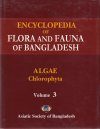![Encyclopedia of Flora and Fauna of Bangladesh, Volume 3: Algae: Chlorophyta Encyclopedia of Flora and Fauna of Bangladesh, Volume 3: Algae: Chlorophyta]()
Click to have a closer look
About this book
Contents
Related titles
About this book
Language: English
From the Introduction: "Division Chlorophyta, or green algae, presented in this volume, are found to grow in fresh and brackish waters as well as in marine habitats with varying range of nutrient and salinity concentrations. A number of them grow as Benthic and Pelagic plankton. Still there are many species of green algae that are capable of growing in terrestrial and subaerial conditions. Their body organization may vary from unicellular to colonial forms, tubular to filamentous, leafy to siphonaceous and pseudoparenchymatous to heterotrichous type. Most of them having cellulosic cell wall and uninucleate to multinucleate chloroplasts. In the cellular pigment content, chlorophyll is predominant and starch is the reserve food.
In Bangladesh, except for the work of Kundu (1929, 1934-35), Banerjee (1935), De (1939) and Fritsch (1945) no other investigation was carried out on algae, particularly after 1945. The reason for such poor record on algae in Eastern Bengal was due to lack of interested workers and the fact that in the University of Dhaka there was no post-graduate classes in Botany until 1948, so that no research could be initiated in any branch of plant sciences. Immediately after partition of India in 1947 all the experienced botanists left the country when the post-graduate class was started with the recruitment of fresh graduates from the Calcutta University as teachers. They were also not interested in algal study and hence the research on this group had to wait for at least a decade, when Professor A.K.M. Nurul Islam started algal studies in the early fifties at the University of Dhaka. Nearly four decades of work resulted in significant contributions to the description of algae in Bangladesh."
Contents
Contents: Introduction
1. Division Chlorophyta
2. Class Chlorophyceae
3. Family Aphanochaetaceae
4. Family Borodinellaceae
5. Family Botryococcaceae
6. Family Bryopsidaceae
7. Family Caulerpaceae
8. Family Chaetopeltidaceae
9. Family Chaetophoraceae
10. Family Characiaceae
11. Family Chlamydomonadaceae
12. Family Chlorangiaceae
13. Family Chlorellaceae
14. Family Chlorococcaceae
15. Family Cladophoraceae
16. Family Coccomyxaceae
17. Family Codiaceae
18. Family Coelastraceae
19. Family Coleochaetaceae
20. Family Cylindrocapsaceae
21. Family Dasycladaceae
22. Family Desmidiaceae
23. Family Dichotomosiphonaceae
24. Family Dunaliellaceae
25. Family Gonatozygonaceae
26. Family Hydrodictyaceae
27. Family Mesotaeniaceae
28. Family Micractiniaceae
29. Family Microsporaceae
30. Family Nephroselmidaceae
31. Family Oedogoniaceae
32. Family Oocystaceae
33. Family Palmellaceae
34. Family Phacotaceae
35. Family Polyblepharidaceae
36. Family Scenedesmaceae
37. Family Schizomeridaceae
38. Family Siphonocladaceae
39. Family Spondylomoraceae
40. Family Tetrasporaceae
41. Family Trentepohliaceae
42. Family Udotiaceae
43. Family Ulotrichaceae
44. Family Ulvaceae
45. Family Valoniaceae
46. Family Volvocaceae
47. Family Zygnemataceae
References
Glossary
Index of scientific names
Index of English names
Index of local names
Classification
Customer Reviews









































